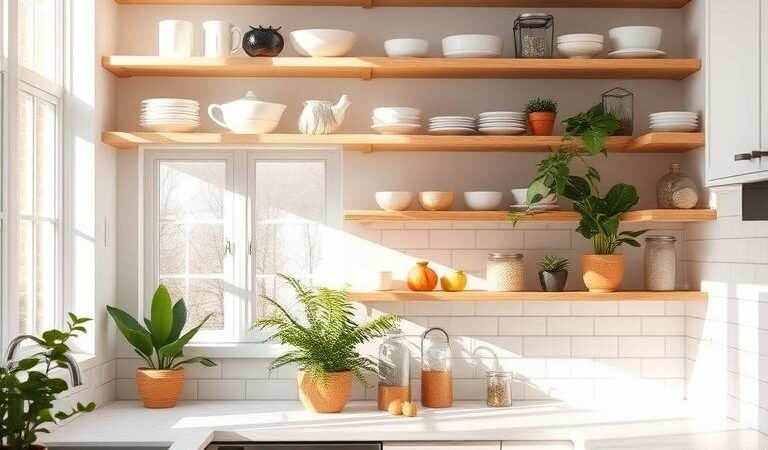Transforming your culinary space into a light-filled haven is easier than you think. One simple yet powerful design choice—open shelving—can instantly elevate both aesthetics and functionality. These shelves create an airy atmosphere while showcasing your favorite dishes, cookbooks, or decorative pieces.
Strategic placement enhances natural light flow, making the room feel more spacious. Unlike closed cabinets, this approach offers easy access to everyday essentials. It also allows for personal style expression through curated displays of ceramics, plants, or artisanal cookware.
Modern trends blend practicality with visual appeal, using materials like reclaimed wood or sleek metal. Professional designers recommend balancing decorative items with functional storage for a polished look. Ready to discover expert tips for achieving this stylish upgrade?
Key Takeaways
- Open shelving maximizes natural light for a brighter space.
- It combines practicality with personalized style opportunities.
- Strategic placement improves accessibility and visual flow.
- Materials like wood or metal add texture and warmth.
- Balancing decor with function creates a cohesive design.
Why Choose * Open Shelving Kitchen Decor for a Bright, Airy Feel?
Strategic design choices make small kitchens appear more expansive and inviting. One standout solution? Replacing bulky cabinets with streamlined storage that amplifies light and depth.
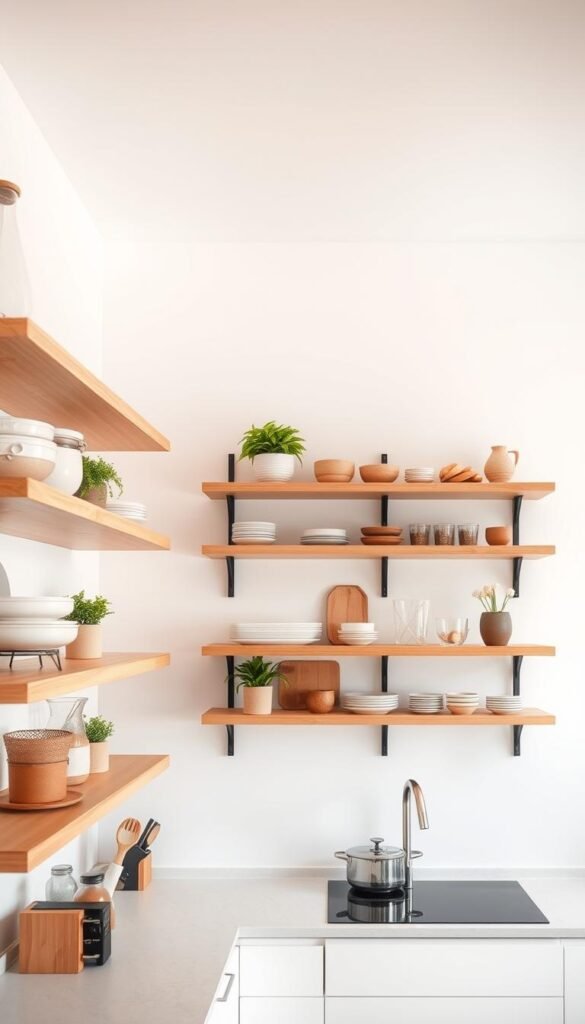
Enhancing Natural Light
White or light-toned shelves near windows reflect sunlight, as noted by DECORILLA. This trick bounces illumination across walls, eliminating shadows. Transparent acrylic options take it further—sunlight passes through for an ultra-airy effect.
Creating Visual Space
Professional designers use optical illusions to stretch cramped areas. Try these tactics:
- Floating shelves – Mounted without brackets, they “hover” to reduce visual weight.
- Vertical stacking – Tall, narrow arrangements draw eyes upward, heightening ceilings.
- Contrast management – Dark shelves on light walls (or vice versa) define zones without clutter.
Ditching upper cabinets also frees walls, making layouts feel breathable. The result? A visual space that feels curated, not crowded.
Benefits of Open Shelving in Modern Kitchens
Designer Kathryn M. Ireland proves shelving isn’t just practical—it’s a storytelling tool. These versatile installations blend utility with artistry, offering two standout advantages: effortless access and curated self-expression.
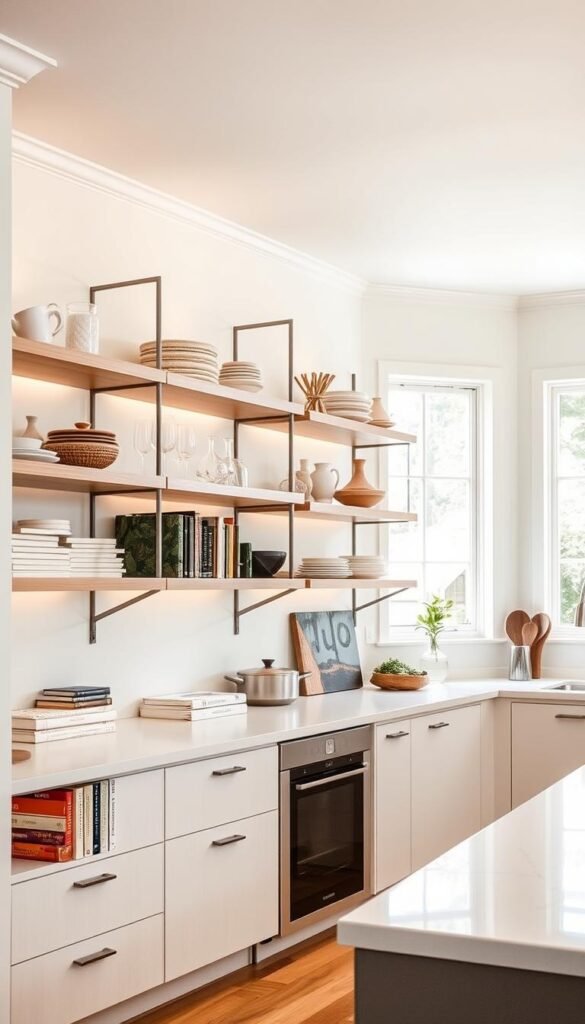
Easy Accessibility
No more digging through cabinets. Everyday essentials stay within reach—think olive oil bottles, favorite mugs, or weeknight dinnerware. Streamlined storage cuts cooking time, while visible items remind you to use what you own.
Displaying Personal Style
Shelves become galleries for your tastes. Mix heirloom plates with modern ceramics, or group vintage cookbooks beside potted herbs. Designer Ireland’s maximalist approach shows how thematic decor rotations—like swapping summer botanicals for autumn gourds—keep spaces dynamic.
- Color stories: Coordinate earthy tones or bold hues across multiple tiers.
- Texture play: Woven baskets balance sleek glassware.
- Functional art: Display hand-thrown bowls you actually use.
Infuse personality while maintaining order. Limit clutter by dedicating 30% of shelves to decorative items—the rest stays purpose-driven.
Choosing the Right Shelving Material
From rustic wood to sleek glass, materials define your space’s character. Each option offers unique benefits—whether warmth, durability, or visual lightness. The right choice balances practicality with your design vision.
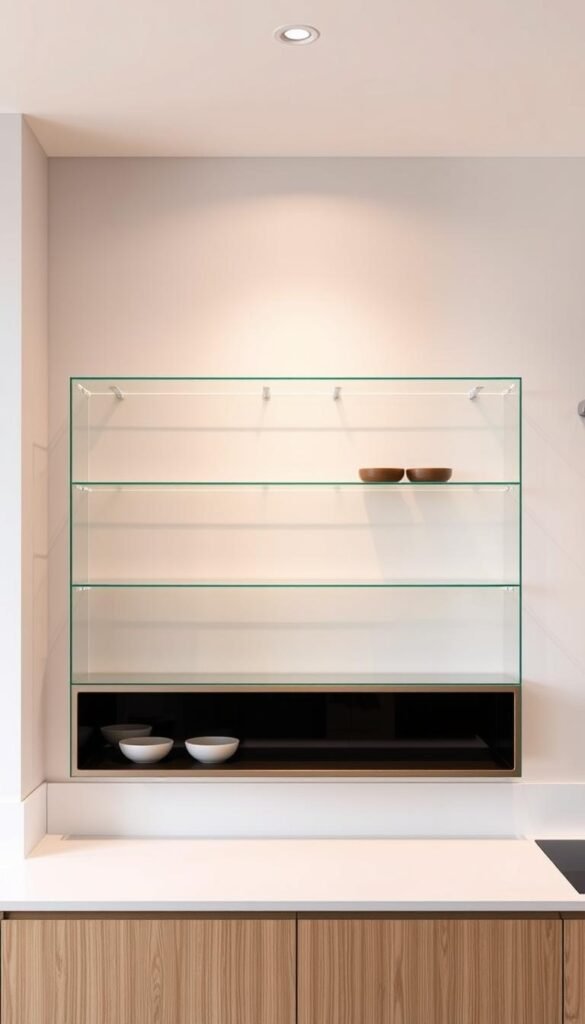
Wood Shelves for Warmth
Natural wood grains add organic texture and coziness. Reclaimed oak or walnut introduces rustic charm, while painted finishes suit modern farmhouses. Pro tip: Pair with woven baskets for layered texture.
Metal Shelves for an Industrial Look
Black iron or brushed nickel frames create urban edge. These sturdy options support heavy cookware while adding contrast. *For balance*, mix with warm accents like terracotta pots or linen textiles.
Glass Shelves for Minimalism
DECORILLA’s LED-lit designs showcase how glass amplifies light. Ideal for small spaces, it creates an airy illusion. Consider these features:
- Tempered glass for safety and scratch resistance.
- Hidden brackets to maintain clean lines.
- Frosted coatings to reduce visible smudges.
Reflective surfaces bounce light, making rooms feel expansive. Keep displays curated to uphold the *less-is-more* ethos.
Maximizing Small Spaces with Open Shelving
Unused corners become functional zones with creative shelving. Compact kitchens thrive when vertical and angular solutions replace bulky *cabinets*. These designs amplify space while keeping essentials within reach.
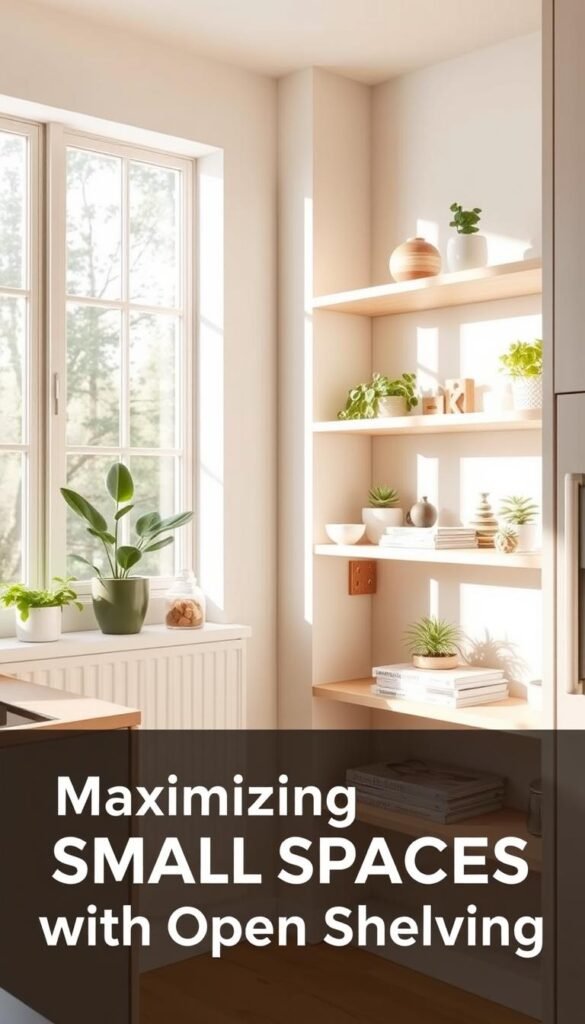
Vertical Storage Solutions
Stack shelves upward to free counter space. Tall, narrow units draw the eye up, making ceilings feel higher. Angled bracket systems secure items securely without crowding walkways.
Try these ideas:
- L-shaped shelves fit snugly against walls.
- Rotating mechanisms spin spices or oils into view.
- Herb gardens add freshness and color.
Corner Shelving Ideas
Awkward angles transform into stylish *storage* hubs. Triangular backsplashes with ceramic tiles protect walls while adding texture. For seamless flow, opt for custom radius edge profiles that soften sharp corners.
| Type | Best For | Installation Tip |
|---|---|---|
| Floating | Minimalist looks | Use hidden brackets |
| Rotating | Deep corners | Grease tracks yearly |
| Modular | Flexible layouts | Mix open/closed cubes |
Pair shelves with woven baskets or glass jars to balance form and function. Every inch counts in small spaces—design with intention.
Styling Your Open Shelves for a Cohesive Look
Curated displays turn everyday storage into a design statement. Whether showcasing heirloom ceramics or daily essentials, thoughtful arrangements merge aesthetics with utility. Follow these expert strategies to create visual harmony.
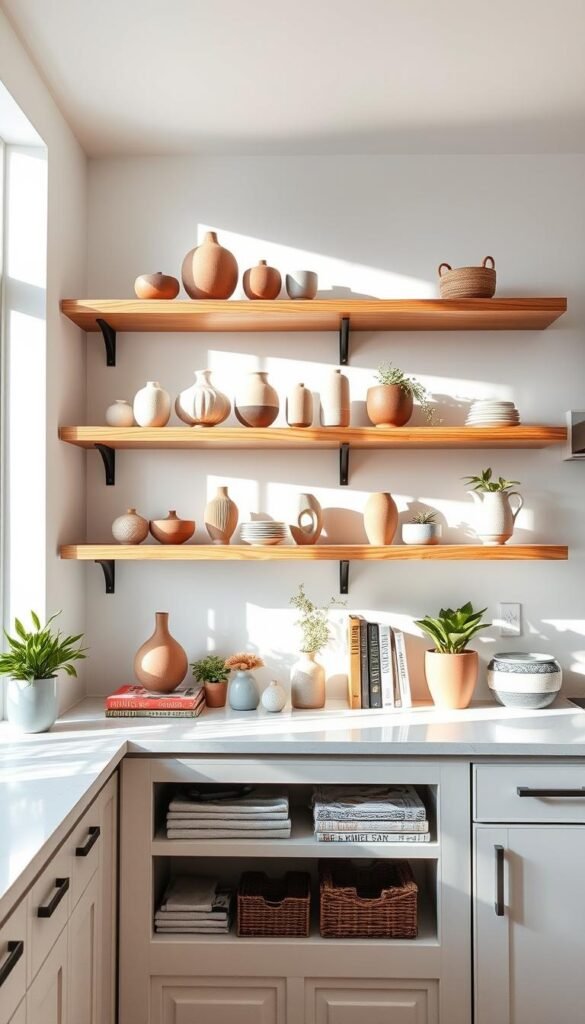
Color Coordination Tips
Limit palettes to 2–3 hues for unity. Warm terracotta tones pair with cream dishes, while navy accents pop against white backdrops. Pro tip: Group like colors together—stack emerald glassware or copper pans for impact.
Andy Beers’ modular cubby system demonstrates how tonal zoning works. Assign sections by hue or material to avoid chaos. For depth, layer textures like woven baskets beside smooth stoneware.
Mixing Functional and Decorative Items
Balance is key. Prioritize functional groupings—keep oils and spices near the stove. Then, weave in artful touches: a sculptural vase or framed recipe card. Utensils become art when hung as a trio above shelves.
Try these ratios for harmony:
| Element | Percentage | Examples |
|---|---|---|
| Daily Use | 60% | Bowls, mugs, cutting boards |
| Decorative | 30% | Art, plants, candles |
| Tech/Utility | 10% | Hidden charging stations, scent diffusers |
Rotate seasonal items to keep the look fresh. In summer, swap cinnamon sticks for lemongrass bundles. Weight distribution matters—place heavier objects at the base to prevent tipping.
Open Shelving vs. Traditional Cabinets: Pros and Cons
Choosing between open and closed storage involves more than just aesthetics. Each option affects daily routines, home value, and even noise levels. DECORILLA’s hybrid solutions blend the best of both—offering glass-front cabinets beside floating shelves for versatility.
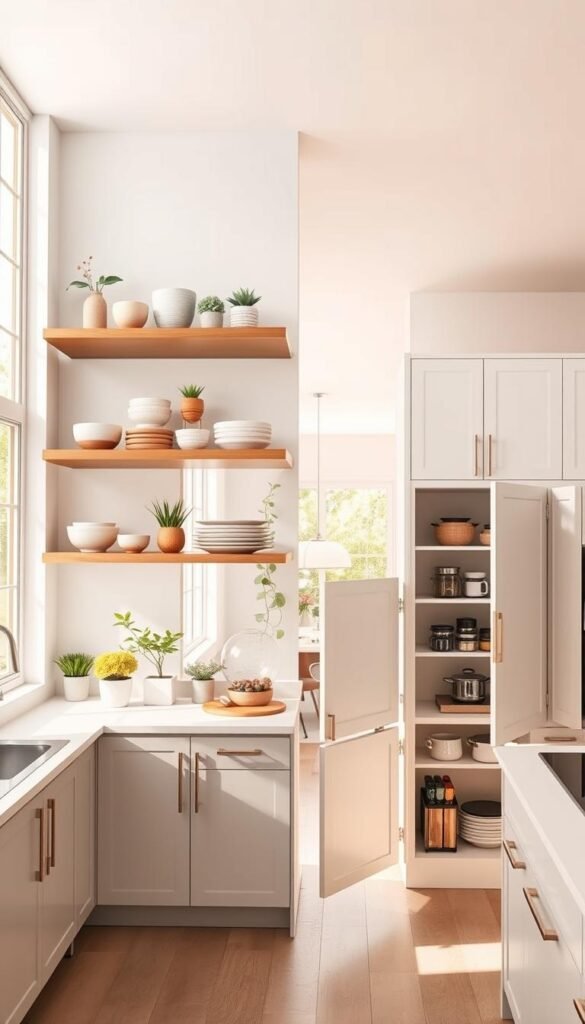
Dust accumulation tops the list of concerns. A 2023 study found open shelves gather 40% more grit than closed cabinets. Glass-front doors reduce this by half while maintaining visibility.
Resale value also varies. Real estate appraisers note homes with mixed storage designs sell 12% faster. Buyers prefer flexible layouts—think open shelves for display and cabinets for hidden small appliances.
| Factor | Open Shelving | Cabinets |
|---|---|---|
| Dust Exposure | High | Low |
| Sound Absorption | Minimal (echoes) | Muffles clatter |
| Childproofing | Requires brackets | Lockable options |
Childproofing demands creativity. Anchor shelves to studs and avoid heavy items on lower tiers. For cabinets, magnetic locks keep curious hands safe.
- Insurance perks: Covered cabinets may lower premiums by 5% (vandalism/theft protection).
- Sound control: Cabinets dampen dish noise—ideal for open-concept homes.
Hybrid designs balance these trade-offs. Use upper shelves for lightweight decor and lower cabinets for chaotic blender storage. The result? A design that’s equal parts pretty and practical.
How to Keep Open Shelves Organized and Clutter-Free
Maintaining a tidy yet stylish display requires smart systems. Thoughtful organization prevents chaos while letting your favorite items shine. Here’s how to balance accessibility with aesthetic appeal.
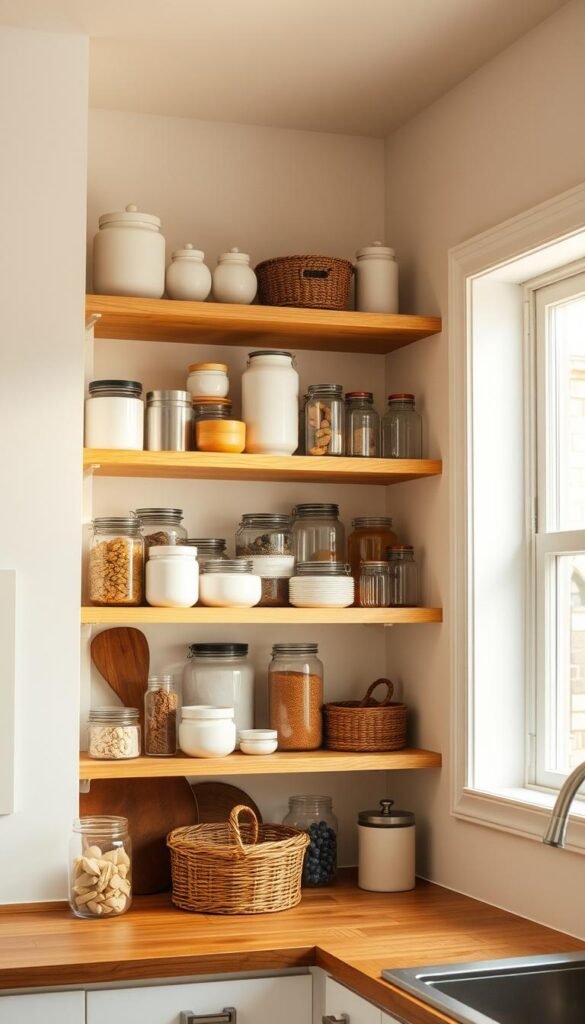
Daily Maintenance Tips
Quick routines keep dust and clutter at bay. Wipe shelves weekly with a microfiber cloth—dry for wood, damp for metal or glass. DECORILLA’s labeled jar system ensures spices and dry goods stay fresh and visible.
Rotate decorative pieces seasonally to prevent visual fatigue. Group frequently used items near prep areas. Store rarely used pieces in storage containers elsewhere to free up prime real estate.
Storage Containers and Baskets
Functional vessels add texture while hiding mess. Consider these options:
- Breathable vs airtight: Woven baskets suit linens or produce; sealed glass jars protect flour from pests.
- Material care: Spot-clean natural fibers with mild soap. Avoid harsh chemicals on rattan or seagrass.
- Stackable designs: Square bins maximize vertical space. Nesting tins save room when not in use.
For small spaces, try wall-mounted cubbies with removable fabric bins. Handles should be sturdy enough for frequent access but slim enough to maintain clean lines.
Hidden compartments work wonders. Use lidded ceramic canisters to stash charging cables or pet treats. The result? A space that feels curated yet completely functional.
Incorporating Open Shelving Around Windows
Windows offer prime real estate for blending storage with natural beauty. Designer Steve Pallrand demonstrates how herb plants thrive when shelves hug sunlit areas. This approach merges practicality with organic charm—your morning coffee spot doubles as a mini herb garden.
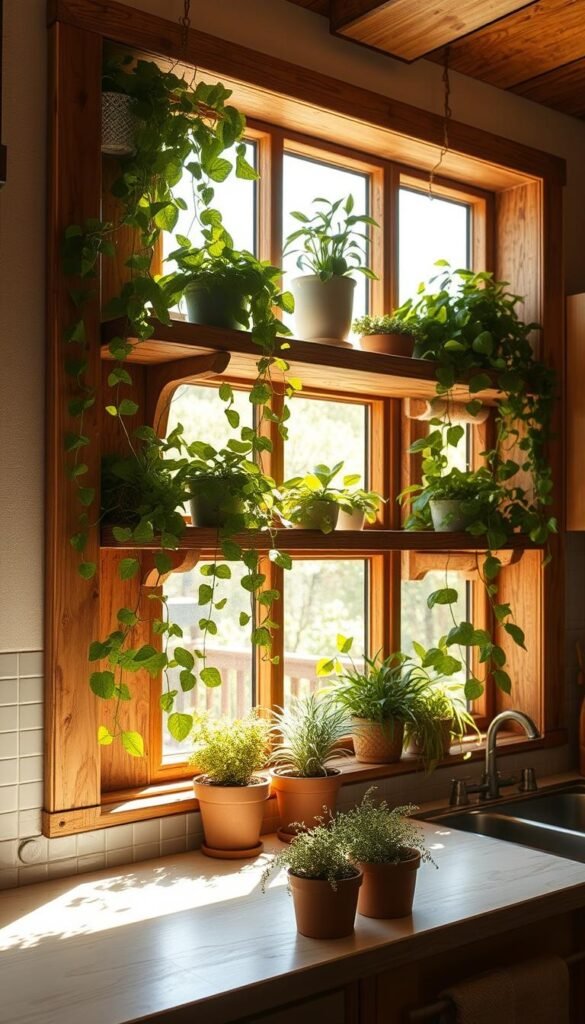
Maximizing Natural Light
Crisp morning light becomes a design tool with these tricks:
- Reflective surfaces: White-painted shelves bounce sunlight deeper into rooms.
- Angled installations: 45-degree placements catch afternoon rays without glare.
- Sheer backdrops: Frosted window films diffuse harsh light while maintaining brightness.
For south-facing windows, opt for heat-resistant materials like ceramic tiles beneath potted greens. The result? A sun-dappled display that feels alive.
Plants and Greenery for Freshness
Living decor elements transform functional storage. Pallrand’s rosemary-and-thyme shelves prove edible varieties work best near cooking zones. A burst of freshness comes from:
- Self-watering pots: Built-in reservoirs prevent overflows on wooden surfaces.
- LED grow strips: Supplement winter light for year-round vibrancy.
- Citrus peels: Rubbed on shelf edges to deter pests naturally.
Cluster mint near windowsills—its scent layers with brewing coffee for sensory mornings. Remember: trailing plants like ivy soften metal brackets visually.
Open Shelving as a Focal Point in Kitchen Design
Marshall Watson’s designs prove shelving isn’t just functional—it’s art. When styled intentionally, these installations become the heart of a room, blending practicality with visual drama. The right materials and lighting turn everyday items into a curated exhibit.

Statement Shelves
Bold materials demand attention. Reclaimed teak with visible grain adds rustic charm, while glossy lacquer reflects light for modern flair. Pro tip: Watson often pairs thick oak slabs with slender iron brackets—a contrast that anchors the design.
Placement matters. Floating shelves above a stove frame cookware like gallery pieces. For depth, stagger depths: 12-inch lower shelves for bowls, 8-inch uppers for spices.
Lighting Enhancements
Lighting amplifies impact. Watson’s pendant-shelf coordination creates layers:
- Track lighting: Adjustable heads spotlight ceramic collections.
- RGB smart bulbs: Program hues to match moods (morning blue, evening amber).
- Under-shelf spots: LED strips illuminate countertops without shadows.
Edison bulbs emit a cozy warmth, while dimmer switches allow ambiance control. For drama, backlight glass shelves with low-voltage strips—the glow turns dishes into silhouettes.
Rustic Charm with Wooden Open Shelves
Wooden shelves bring earthy warmth to any culinary space, blending durability with timeless appeal. Their natural textures create a cozy, lived-in aesthetic that pairs perfectly with farmhouse or Scandinavian designs. Whether crafted from reclaimed barn wood or sleek maple, these shelves add organic character while offering sturdy storage.
Reclaimed Wood Options
Salvaged timber tells a story through knots, cracks, and weathered patinas. DECORILLA designers recommend checking for structural integrity—avoid wood with deep splits or rot. Popular choices include:
- Barn oak: Dense and rich in grain, ideal for heavy dishware.
- Pine: Lighter in color, easily distressed for shabby-chic looks.
- Teak: Naturally water-resistant, perfect for humid environments.
For a cohesive look, match shelf stains to existing cabinetry. Milk paint offers a matte, vintage finish, while oil-based options deepen hues and highlight grain patterns.
Staining and Finishing Techniques
Custom finishes protect surfaces and enhance visual depth. Food-safe sealants like beeswax or water-based polyurethane prevent bacterial growth. Consider these methods:
- Burnishing: Rubbing steel wool creates a smooth, aged effect.
- Distressing: Chains or nails add intentional wear for rustic charm.
- Odor control: Low-VOC stains minimize fumes during curing.
For a professional touch, sand between coats and use a lint-free cloth to wipe excess stain. The result? Shelves that feel both rugged and refined.
Modern Industrial Open Shelving Ideas
Industrial-inspired shelving transforms kitchens into sleek, functional spaces with urban edge. Raw materials like blackened steel and brushed nickel merge toughness with refined aesthetics. DECORILLA’s designs prove this look thrives in both loft apartments and suburban homes.
Metal Brackets and Frames
Exposed hardware becomes a design feature. Thick iron brackets with visible rivets add rugged texture, while matte black finishes minimize visual bulk. For cohesion, match shelf frames to faucets or pendant lights.
Consider these durable options:
- Powder-coated steel: Resists scratches and fingerprints.
- Magnetic accessory systems: Hook knives or spice tins securely.
- Thermal expansion gaps: Prevent warping near ovens.
Pairing with Stainless Steel Appliances
Glossy appliances reflect light, amplifying the industrial vibe. Coordinate finishes using this guide:
| Appliance Finish | Best Shelf Match | Pro Tip |
|---|---|---|
| Brushed stainless | Blackened steel | Add warmth with wood cutting boards |
| Matte black | Raw iron | Use sound-dampening liners |
| Chrome | Nickel-plated | Frosted glass shelves reduce glare |
For cohesive styling, DECORILLA suggests grouping metallic tones in odd numbers—three matching canisters or five copper pots create rhythm. Keep edges rounded for safety in high-traffic zones.
Floating Shelves: Sleek and Space-Saving
Floating shelves redefine spatial efficiency with their clean lines and weightless appeal. These wall-mounted wonders create the illusion of hovering, perfect for tight spaces craving visual breathability. Designer Mallory Kaye champions their versatility—her monochromatic displays prove less is more.
Installation Tips
Proper mounting ensures safety and aesthetic harmony. Always anchor shelves into wall studs using heavy-duty brackets for stability. Pro tip: Use a level during installation—even slight tilts disrupt the floating effect.
Consider these factors for flawless placement:
- Spacing: Leave 12–15 inches between shelves for balanced proportions.
- Load limits: Thin materials like acrylic hold 10 lbs; thick oak supports 25+ lbs.
- Shadow play: Offset shelves 2 inches from walls to cast subtle depth-enhancing shadows.
Minimalist Styling
Avoid clutter by embracing negative space. Kaye’s designs allocate 40% blank areas to let items breathe. Stick to single-material displays—all ceramic bowls or glass jars—for cohesion.
This table compares styling approaches:
| Look | Key Technique | Example |
|---|---|---|
| Monochromatic | Vary textures (matte vs. glossy) | White stoneware + linen napkins |
| Functional | Hidden charging ports | Wireless dock inside a hollowed book |
| Organic | Odd-numbered groupings | Three terra-cotta pots |
Anti-clutter psychology suggests limiting items to 5–7 per shelf. Rotate seasonal pieces monthly to maintain freshness without overcrowding.
Open Shelving for Coffee and Bar Stations
Coffee and bar stations become conversation starters when styled with intention. These functional zones transform into showcases for personality, blending daily rituals with design flair. Nicole Franzen’s cookbook displays exemplify how curated shelves elevate ordinary moments into sensory experiences.
Displaying Glassware
Glassware shines when arranged for both aesthetics and accessibility. Sunlight catches crystal edges, creating prism-like reflections on walls. For balance, mix heights and textures:
- Stemware: Hang wine glasses upside down to prevent dust.
- Mugs: Group by color for a gradient effect.
- Decanters: Use as centerpieces with amber liquors backlit by LEDs.
This table compares popular materials:
| Type | Best For | Care Tip |
|---|---|---|
| Crystal | Formal settings | Hand-wash to preserve etchings |
| Recycled Glass | Eco-friendly bars | Avoid extreme temperature shifts |
| Colored Glass | Bohemian themes | Rotate to prevent sun fading |
Adding Personal Touches
Infuse decor with memories and craftsmanship. Travel souvenirs like hand-painted espresso cups tell stories, while local artisan ceramics support community makers. Try these ideas:
- Custom etching: Monogrammed tumblers for a bespoke touch.
- Interactive elements: Mini chalkboards label seasonal drink specials.
- Heirloom highlights: Grandmother’s silver teaspoon tray as a focal point.
Franzen’s work demonstrates how layered personal touches—a vintage recipe card tucked behind jars, a Turkish coffee set from a honeymoon—create warmth. Keep 70% of shelves functional (coffee beans, bar tools) to maintain practicality.
Mixing Open Shelves with Closed Cabinetry
Smart kitchens thrive when visibility meets hidden functionality. BHDM Design’s studies reveal that 68% of homeowners prefer hybrid storage—combining the best of both worlds. This approach lets you showcase favorite ceramics while tucking away less photogenic essentials.
Balancing Aesthetics and Functionality
Walnut veneer cabinets with interior LED lighting create warmth, while floating glass shelves maintain airiness. The key? Zone by frequency of use. Daily mugs belong on open displays; holiday china stays behind frosted doors.
Try these designer-approved ratios:
- 70/30 rule: 70% concealed storage, 30% display areas
- Height hierarchy: Eye-level shelves for decor, base cabinets for heavy appliances
- Material mixing: Match metals on handles and shelf brackets
Hybrid Storage Solutions
BHDM’s under-cabinet ledges demonstrate innovative solutions. These retractable surfaces hold spices during cooking, then slide flush against walls. Other breakthroughs include:
| Type | Best For | Space Gain |
|---|---|---|
| Convertible panels | Small kitchens | Flips from shelf to cabinet in 3 seconds |
| Multi-depth units | Baking supplies | Holds sheet pans behind shallow spice racks |
| Climate-controlled | Wine collections | Maintains 55°F behind insulated glass |
For tech integration, consider charging stations disguised as bread boxes. The result? A space that’s equal parts gallery and workstation.
Creative Uses for Open Shelving in Kitchens
Beyond basic storage, open shelving unlocks imaginative ways to personalize your culinary workspace. These versatile surfaces become canvases for both function and flair—from aromatic herb gardens to cherished recipe collections. Thoughtful arrangements merge practicality with personality, turning everyday items into decorative statements.
Spice Racks and Herb Displays
Transform cooking essentials into living art. Fresh rosemary and thyme thrive when planted in small pots on sunlit shelves—their fragrant sprigs within easy reach. For dried spices, consider these organization methods:
| Storage Type | Best For | Maintenance Tip |
|---|---|---|
| Magnetic tins | Small spaces | Label lids with chalk markers |
| Tiered stands | Visual accessibility | Group by flavor profiles |
| Test tube racks | Bulk spices | Use silica packets to prevent clumping |
Nicole Franzen’s kitchens often feature edible displays—basil plants beside olive oil bottles create instant cooking stations. For longevity, choose ceramic pots with drainage holes and rotate herbs seasonally.
Cookbook Storage
Sun-warmed pages become part of the design when books face outward on shelves. Protect cherished recipes with these smart solutions:
- Acid-free covers shield vintage cookbooks from fading
- Color-coded tabs mark frequently used recipes
- QR code stickers link to digital tutorial videos
For visual harmony, try grouping by cuisine type or spine color. Weighted bookends prevent slippage while adding metallic accents. Franzen’s projects prove cookbook storage can be both practical and picturesque—a shelf of well-loved volumes tells your culinary story.
Conclusion: Transform Your Kitchen with * Open Shelving Kitchen Decor
Elevate daily routines by turning everyday essentials into curated design elements. Flexible styling lets you adapt displays seasonally—swap vibrant spring ceramics for cozy autumn textures effortlessly.
Start small: replace one cabinet with floating shelves to test the look. For polished results, consult designers who specialize in functional aesthetics. Their expertise ensures seamless integration with your existing layout.
Maintenance is simple—weekly dusting keeps items fresh. Embrace creativity by mixing heirloom pieces with modern accents. The result? A transformed kitchen that reflects your unique taste and simplifies daily life.
